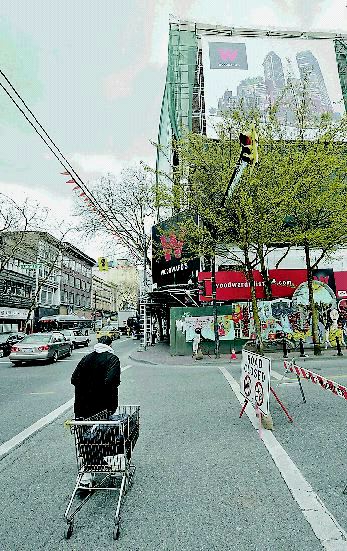Frances Bula
Sun

Construction continues at the Woodwards site in the Downtown Eastside, where it is a frequent sight to see the homeless around multi-million dollar developments. Photograph by : Ward Perrin, Vancouver Sun

Billboard at Richards and Pender. One of the biggest issues: What kind of businesses can and will work for the area. Photograph by : Glenn Baglo, Vancouver Sun

Construction continues around the Woodwards site in the Downtown Eastside Photograph by : Ward Perrin, Vancouver Sun
An unusual group of businessmen and community activists has waded into Vancouver‘s most contentious neighbourhood to try to help developers, the city and low-income advocates agree on a new common vision for the Downtown Eastside.
It’s one that Milton Wong, the businessman and philanthropist who is one of the leaders of the group, along with former Carnegie Centre director Michael Clague, hopes will be open to business while respecting the existing low-income residents.
The group has proposed the city consider designating the Downtown Eastside a “special development zone,” creating a special trust fund paid by development fees, and/or establishing a community development corporation, as a way of helping realize the new future for the neighbourhood.
They say those unique mechanisms — or something else equally unique — are needed because the Downtown Eastside, the traditional inner-city home for more than a century to the city’s poorest residents, is facing its most severe development pressures ever.
That pressure showed the first visible signs of erupting into conflict last week, when Downtown Eastside groups halted a Concord Pacific development permit temporarily for a 154-unit on Hastings Street in the heart of the neighbourhood.
That stall — caused when someone discovered city planners hadn’t sent out the required notice about the project to local groups — is unlikely to permanently block the Concord project, since it has been designed for existing zoning and doesn’t need any special city approvals. But the mini-skirmish does provide an early glimpse into the kind of bitter stand-offs that could emerge on a regular basis down the road.
It would be wrong to say the city has no rules or ideas at all when it comes to the Downtown Eastside.
There are zoning policies and a housing plan and any number of initiatives underway in the 40-block area. But people like Wong, Clague and local advocates say there’s a sense that no one is overseeing the big picture. Certainly, no one is making the case forcefully that development has to be done in a way that’s respectful to existing residents, something Wong and Clague say is the foundation for whatever happens.
“The Downtown Eastside is balkanized with plans and good intentions but there’s nothing integrated,” Clague said.
Some people, including influential condo marketer Bob Rennie, have said the city needs a “Downtown Eastside czar,” and there were rumours that the provincial government was going to appoint one.
But Clague and Wong, who met in 2003 when Clague was looking for people to help put on the Carnegie Centre’s 100th birthday, have opted for a more communal approach with their Downtown Eastside Community Land Use Principles project (Declup to insiders). That project has attracted senior city planners, architects, development consultants, housing activists, and former premier Mike Harcourt to its meetings and workshops over the past 18 months. (The core group includes architect Joe Wai, retired Jewish Community Centre director Gerry Zipursky, former city planning director Ray Spaxman, Tim Pringle of the Real Estate Foundation, researcher Andy Yan, Maggie Geiser of the activist Citywide Housing Coalition, and the man who developed SFU’s UniverCity, Michael Geller.)
‘We do want business
to come in’
Wong makes it clear that he is advocating for both business and the low-income community.
“We’re not neutral. We do want business to come in, but it has to be on the condition of respect and accommodation for low-income people. We champion the low-income group, making sure they have space, not just physical space, but spiritual and other space.”
Declup is seen by activists as a way to ensure the neighbourhood continues to feel like home for low-income residents, and is seen by developers as a way to do projects that will be accepted by the community. It may even evolve into a community development corporation to achieve its goal of creating more low-income housing.
“This is exactly the kind of planning process we have to have. They’re filling a void,” said David Eby of Pivot Legal Society, the legal advocacy group that has emerged in recent years as one of the most vocal champions for the Downtown Eastside.
Wendy Pedersen from the Carnegie Community Action Project says Wong and Clague do something that she and her groups can’t, in spite of their vocal protests.
“They’re the missing link. We do need our champions.”
Geller, who has worked in development most of his life, also says he believes the group is doing critically important work.
“If we don’t start to do something, I fear we could have some real battles between the middle class moving in and the poor who live there already.”
For Wong, the most important part of what they’re doing is helping the community understand how development works and what it can do for them, while talking to developers about what they need to do differently.
“Developers look for rules, but they are accustomed to a certain development approach,” Wong said. “They’re not used to taking into account the needs of the homeless and low-income.”
A former city planner working with the group, Michael Mortenson, has developed a spreadsheet that lets people figure out the finances of building housing, letting them see in an easy-to-understand format what happens when you put in X dollars of government funding, X dollars of income from a retail business, and X dollars of welfare-level rent payments to finance housing.
At a workshop in January, everyone who attended got to play around with it, looking at how to finance a building under different scenarios.
One of the things that exercise showed people, said Clague, is that people shouldn’t count on paying for social housing in the area by allowing developers extra density for market housing in exchange. That concept, one that former city councillor Jim Green has advocated for developers he’s working with in the Downtown Eastside, has been used a couple of times in other parts of the city. But the exercise indicated it would take eight or nine extra units of marketing housing to pay for one unit of social housing, Clague said. And that would mean having to stuff an incredible amount of development into a small area.
The whole notion of towers coming to the Downtown Eastside is already a contentious point since Coun. Suzanne Anton added a new twist to the city’s EcoDensity plan earlier this year by suggesting that increased height be considered for Gastown, Chinatown and the Downtown Eastside.
That’s provoked a clear-cut negative response from the Declup group.
“The notion of extending the False Creek and Marathon models here is a disservice to the community,” Clague said.
To figure out what physical form people do want, Geller is helping organize a neighbourhood design workshop so community groups can do some physical planning, as a follow-up to earlier workshops on a general vision for the area.
Finally, the group is being watched with interest by city hall senior managers and planners, who have spent a considerable amount of time meeting with the group and going to its events.
While city planners don’t exactly embrace the idea that their department has left a void, they do say the group can play a role that city officials can’t always do.
“They bring a lot of folks together,” says the city’s head planner, Brent Toderian.
The biggest issues the Downtown Eastside faces are: What is the ultimate mix of people the neighbourhood should be home to? And what kinds of businesses can and will work for the neighbourhood?
Pedersen, expressing the views of many, says people want to feel like it’s still their home. That means not feeling like poor people living next to yuppies or feeling out of place in upscale stores clearly meant to serve only part of the neighbourhood.
“People are really attached to stores like Army & Navy here, where the staff all look like you, so it doesn’t make you feel poor. This is a bit of a safe enclave from poor-bashing.”
To her, that means the community has to maintain a balance of about 70 to 75 per cent low-income housing, with 25 to 30 per cent living in private housing. But even the private housing should be geared to people at the lower end of the market, artists and lower-paid workers who will blend with everyone else. Then the business mix has to match that.
Area has been ‘discovered’
in the last two to three years
The city’s official policy, expressed in its 2005 Downtown Eastside housing plan, is that the neighbourhood “remains the primary community for the low-income singles in the city and region while new market housing is integrated.”
That plan said in 2005 that the city’s aim was to “stabilize” the 10,000 units of low-income housing that have been at the core of the neighbourhood for decades. It envisioned there would be 4,000 units of market housing by 2014.
But there are now 1,750 market units in planning or under construction, almost double the amount of market housing that existed in 2005.
“This area has been discovered and it’s all happened in the last two or three years,” Geller says. “The land down here is currently selling for more than prime sites in Burnaby.”
The city’s new Downtown Eastside senior planner, Jessica Chen, said her planners can’t even project what the proportion of market units is likely to be with that pace of construction.
To have an impact on that rate of development, the group is going to have to decide what kind of mechanism it wants in place.
So far, that hasn’t happened in spite of its creative suggestions.
Wong said it’s an evolving process.
It could be the community-development corporation. It could even be something like the Shaughnessy or Gastown advisory committees, two city panels that vet any developments that come to their area.
Geller said one possibility is that the fees currently collected from developers on any new construction in the city could, in the case of Downtown Eastside projects, be turned over to the community corporation to manage. That would give them money to invest in housing or local businesses or whatever they decided would help preserve the Downtown Eastside they want.
But nothing is decided yet.
At the other end, the city is waiting to see what the group might come up with.
“I’m trying to understand their aspirations and then match their tools to that,” planning director Toderian says. “We don’t know what that is yet, though. But I see them as a force for the good. Every once in a while, the best people for a job are not in city hall.”
[email protected]
© The Vancouver Sun 2008
Common vision
Businessmen, activists join forces to help developers find solutions for Downtown Eastside
Frances Bula, Vancouver Sun
Published: Saturday, May 03, 2008
An unusual group of businessmen and community activists has waded into Vancouver‘s most contentious neighbourhood to try to help developers, the city and low-income advocates agree on a new common vision for the Downtown Eastside.
It’s one that Milton Wong, the businessman and philanthropist who is one of the leaders of the group, along with former Carnegie Centre director Michael Clague, hopes will be open to business while respecting the existing low-income residents.
The group has proposed the city consider designating the Downtown Eastside a “special development zone,” creating a special trust fund paid by development fees, and/or establishing a community development corporation, as a way of helping realize the new future for the neighbourhood.
They say those unique mechanisms — or something else equally unique — are needed because the Downtown Eastside, the traditional inner-city home for more than a century to the city’s poorest residents, is facing its most severe development pressures ever.
That pressure showed the first visible signs of erupting into conflict last week, when Downtown Eastside groups halted a Concord Pacific development permit temporarily for a 154-unit on Hastings Street in the heart of the neighbourhood.
That stall — caused when someone discovered city planners hadn’t sent out the required notice about the project to local groups — is unlikely to permanently block the Concord project, since it has been designed for existing zoning and doesn’t need any special city approvals. But the mini-skirmish does provide an early glimpse into the kind of bitter stand-offs that could emerge on a regular basis down the road.
It would be wrong to say the city has no rules or ideas at all when it comes to the Downtown Eastside.
There are zoning policies and a housing plan and any number of initiatives underway in the 40-block area. But people like Wong, Clague and local advocates say there’s a sense that no one is overseeing the big picture. Certainly, no one is making the case forcefully that development has to be done in a way that’s respectful to existing residents, something Wong and Clague say is the foundation for whatever happens.
“The Downtown Eastside is balkanized with plans and good intentions but there’s nothing integrated,” Clague said.
Some people, including influential condo marketer Bob Rennie, have said the city needs a “Downtown Eastside czar,” and there were rumours that the provincial government was going to appoint one.
But Clague and Wong, who met in 2003 when Clague was looking for people to help put on the Carnegie Centre’s 100th birthday, have opted for a more communal approach with their Downtown Eastside Community Land Use Principles project (Declup to insiders). That project has attracted senior city planners, architects, development consultants, housing activists, and former premier Mike Harcourt to its meetings and workshops over the past 18 months. (The core group includes architect Joe Wai, retired Jewish Community Centre director Gerry Zipursky, former city planning director Ray Spaxman, Tim Pringle of the Real Estate Foundation, researcher Andy Yan, Maggie Geiser of the activist Citywide Housing Coalition, and the man who developed SFU’s UniverCity, Michael Geller.)
‘We do want business
to come in’
Wong makes it clear that he is advocating for both business and the low-income community.
“We’re not neutral. We do want business to come in, but it has to be on the condition of respect and accommodation for low-income people. We champion the low-income group, making sure they have space, not just physical space, but spiritual and other space.”
Declup is seen by activists as a way to ensure the neighbourhood continues to feel like home for low-income residents, and is seen by developers as a way to do projects that will be accepted by the community. It may even evolve into a community development corporation to achieve its goal of creating more low-income housing.
“This is exactly the kind of planning process we have to have. They’re filling a void,” said David Eby of Pivot Legal Society, the legal advocacy group that has emerged in recent years as one of the most vocal champions for the Downtown Eastside.
Wendy Pedersen from the Carnegie Community Action Project says Wong and Clague do something that she and her groups can’t, in spite of their vocal protests.
“They’re the missing link. We do need our champions.”
Geller, who has worked in development most of his life, also says he believes the group is doing critically important work.
“If we don’t start to do something, I fear we could have some real battles between the middle class moving in and the poor who live there already.”
For Wong, the most important part of what they’re doing is helping the community understand how development works and what it can do for them, while talking to developers about what they need to do differently.
“Developers look for rules, but they are accustomed to a certain development approach,” Wong said. “They’re not used to taking into account the needs of the homeless and low-income.”
A former city planner working with the group, Michael Mortenson, has developed a spreadsheet that lets people figure out the finances of building housing, letting them see in an easy-to-understand format what happens when you put in X dollars of government funding, X dollars of income from a retail business, and X dollars of welfare-level rent payments to finance housing.
At a workshop in January, everyone who attended got to play around with it, looking at how to finance a building under different scenarios.
One of the things that exercise showed people, said Clague, is that people shouldn’t count on paying for social housing in the area by allowing developers extra density for market housing in exchange. That concept, one that former city councillor Jim Green has advocated for developers he’s working with in the Downtown Eastside, has been used a couple of times in other parts of the city. But the exercise indicated it would take eight or nine extra units of marketing housing to pay for one unit of social housing, Clague said. And that would mean having to stuff an incredible amount of development into a small area.
The whole notion of towers coming to the Downtown Eastside is already a contentious point since Coun. Suzanne Anton added a new twist to the city’s EcoDensity plan earlier this year by suggesting that increased height be considered for Gastown, Chinatown and the Downtown Eastside.
That’s provoked a clear-cut negative response from the Declup group.
“The notion of extending the False Creek and Marathon models here is a disservice to the community,” Clague said.
To figure out what physical form people do want, Geller is helping organize a neighbourhood design workshop so community groups can do some physical planning, as a follow-up to earlier workshops on a general vision for the area.
Finally, the group is being watched with interest by city hall senior managers and planners, who have spent a considerable amount of time meeting with the group and going to its events.
While city planners don’t exactly embrace the idea that their department has left a void, they do say the group can play a role that city officials can’t always do.
“They bring a lot of folks together,” says the city’s head planner, Brent Toderian.
The biggest issues the Downtown Eastside faces are: What is the ultimate mix of people the neighbourhood should be home to? And what kinds of businesses can and will work for the neighbourhood?
Pedersen, expressing the views of many, says people want to feel like it’s still their home. That means not feeling like poor people living next to yuppies or feeling out of place in upscale stores clearly meant to serve only part of the neighbourhood.
“People are really attached to stores like Army & Navy here, where the staff all look like you, so it doesn’t make you feel poor. This is a bit of a safe enclave from poor-bashing.”
To her, that means the community has to maintain a balance of about 70 to 75 per cent low-income housing, with 25 to 30 per cent living in private housing. But even the private housing should be geared to people at the lower end of the market, artists and lower-paid workers who will blend with everyone else. Then the business mix has to match that.
Area has been ‘discovered’
in the last two to three years
The city’s official policy, expressed in its 2005 Downtown Eastside housing plan, is that the neighbourhood “remains the primary community for the low-income singles in the city and region while new market housing is integrated.”
That plan said in 2005 that the city’s aim was to “stabilize” the 10,000 units of low-income housing that have been at the core of the neighbourhood for decades. It envisioned there would be 4,000 units of market housing by 2014.
But there are now 1,750 market units in planning or under construction, almost double the amount of market housing that existed in 2005.
“This area has been discovered and it’s all happened in the last two or three years,” Geller says. “The land down here is currently selling for more than prime sites in Burnaby.”
The city’s new Downtown Eastside senior planner, Jessica Chen, said her planners can’t even project what the proportion of market units is likely to be with that pace of construction.
To have an impact on that rate of development, the group is going to have to decide what kind of mechanism it wants in place.
So far, that hasn’t happened in spite of its creative suggestions.
Wong said it’s an evolving process.
It could be the community-development corporation. It could even be something like the Shaughnessy or Gastown advisory committees, two city panels that vet any developments that come to their area.
Geller said one possibility is that the fees currently collected from developers on any new construction in the city could, in the case of Downtown Eastside projects, be turned over to the community corporation to manage. That would give them money to invest in housing or local businesses or whatever they decided would help preserve the Downtown Eastside they want.
But nothing is decided yet.
At the other end, the city is waiting to see what the group might come up with.
“I’m trying to understand their aspirations and then match their tools to that,” planning director Toderian says. “We don’t know what that is yet, though. But I see them as a force for the good. Every once in a while, the best people for a job are not in city hall.”
© The Vancouver Sun 2008


















